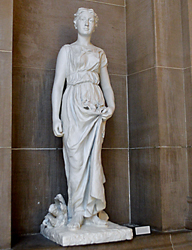This statue, simply named "Indiana," was created to be displayed in the Indiana Building at the Columbian Exposition in 1893. Also called the Chicago World's Fair, the Exposition celebrated the 400th anniversary of the voyage of Christopher Columbus to the New World.
President Benjamin Harrison signed the act that officially established the event, which was held from May 1 to October 30 of 1893.
The Indiana statue is approximately five feet, ten inches tall. Made of metal, it is covered in white, which might be lead-based paint but could also be a thin layer of plaster, cement, and jute fibers. The face of the statue looks to her right. Her hair is wrapped loosely into a bun. She is dressed in a toga that is banded at the waist. The skirt is gathered into her left hand where she holds a cluster of what appear to be morning glory flowers. She is wearing sandals.
This statue was sculpted by Retta Matthews from Arlington, Indiana. She was one of three women chosen to create statues to be displayed at the Exposition. The other two statues were "Nymph" by Janet Scudder of Terre Haute and "Education" by Frances Goodwin from New Castle.
The three statues were featured prominently in the main reception room of the Indiana Building at the Exposition. "Indiana" was considered to be an "ideal figure of Indiana." The Rand-McNally Handbook for the Exposition suggested that its title was "The Maid of the Wabash," but no other sources seem to support that designation.
The Indiana Building was described as French Gothic in style. It sported numerous pinnacles and two tall towers, each 120 feet in height. Gables stood above each window and door. In the center of each gable was engraved the Great Seal of Indiana. The roof of the three-story structure was covered with red and gray shingles. Bedford limestone was used throughout the building.
Hoosiers were close enough to Chicago that many of them attended the Exposition more than once. September 27, 1893, was designated "Indiana Day" and over 100,000 Indiana citizens went to the fair on that day alone. Over the course of the event, nearly one in seven Hoosiers traveled to the Exposition. They took pride not only in their state's building, but in the wide variety of Indiana products displayed throughout many other buildings.
Statue History
At the conclusion of the Exposition, the Indiana Board of Managers directed that the statues be given back to the people of the state. It has been reported that "Nymph" by Janet Scudder went to her hometown of Terre Haute where it was placed in the Emeline Fairbanks Memorial Library. However, it has since gone missing.
"Education" by Frances Goodwin is seen standing in an 1896 photograph of the Indiana Governor's office. It is reported to have gone to the Propylaeum in Indianapolis. Its location now is unknown. Frances Goodwin also created a bronze bust of Robert Dale Owen which was placed on a limestone pedestal on the south lawn of the Indiana State House. This sculpture, too, is missing.
The "Indiana" statue was given to the Indiana Statehouse where it has remained and can be seen and enjoyed to this day.
Sculptor
Retta Matthews
Retta Matthews was born in Arlington, Indiana, on April 7, 1856. She studied art at the Cincinnati Museum Association Art School. Early in her career she was an art teacher in the San Antonio, Texas, school system. She later continued her studies in Paris, where she worked with M. Ingelbert. She lived in Paris for most of the rest of her life. She became ill and returned home to Indiana, where she died on February 24, 1899 at the age of 42. She is buried in Arlington East Hill Cemetery in Rush County.
http://www.chicagohs.org/history/expo.html
Interview with mother of Retta Matthews, Indianapolis News, September 14, 1901, page 20.
"A Moment of History," WFIU Public Radio, based on Indiana Magazine of History published by the Indiana University Department of History
"Pride, Profits, and Politics: Indiana and the Columbian Exposition of 1893" Frank A. Cassell and Marguerite E. Cassell, Indiana Magazine of History 80, no. 2 (June 1984): 93-121.
Rand McNally & Company Handbook for the Columbian Exposition, published 1893.
"Report of the Board of World's Fair Managers of Indiana," Indianapolis, Wm. B. Burford, 1895, pp. 31-33.

